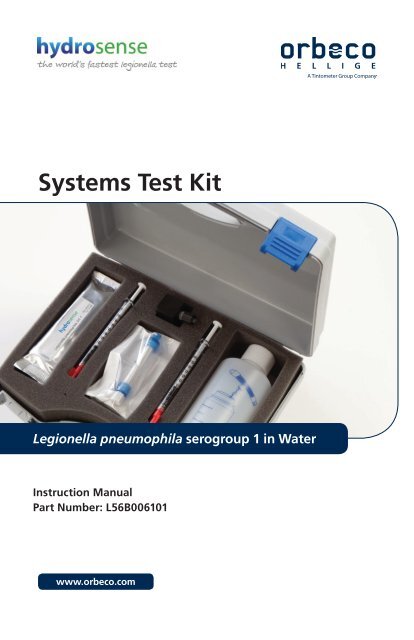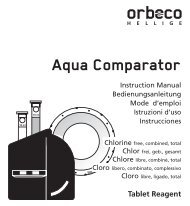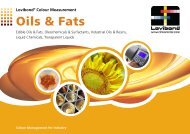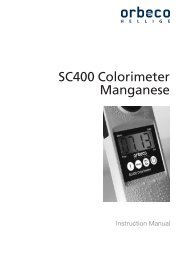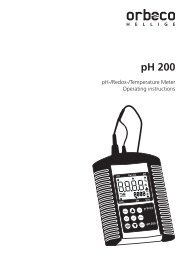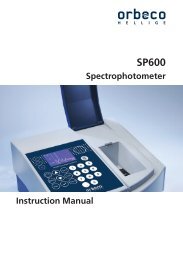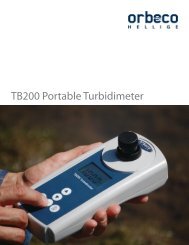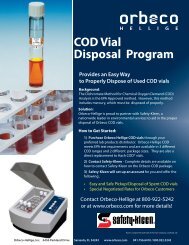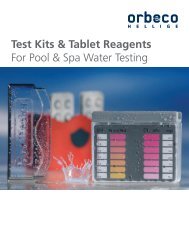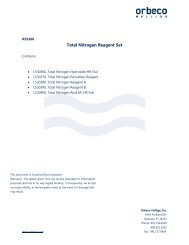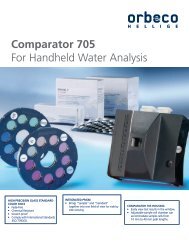Legionella Systems Test Kit Manual - Orbeco-Hellige
Legionella Systems Test Kit Manual - Orbeco-Hellige
Legionella Systems Test Kit Manual - Orbeco-Hellige
You also want an ePaper? Increase the reach of your titles
YUMPU automatically turns print PDFs into web optimized ePapers that Google loves.
<strong>Systems</strong> <strong>Test</strong> <strong>Kit</strong><br />
<strong>Legionella</strong> pneumophila serogroup 1 in Water<br />
Instruction <strong>Manual</strong><br />
Part Number: L56B006101<br />
www.orbeco.com
Technical Information<br />
Overview<br />
The <strong>Legionella</strong> <strong>Systems</strong> <strong>Test</strong> <strong>Kit</strong> is for detecting <strong>Legionella</strong> in a water sample -- it is ideal for on-line and a variety<br />
of industrial applications.<br />
The test operates via a Lateral Flow Immuno-Chromatographic Assay (LFICA).<br />
Each <strong>Systems</strong> <strong>Test</strong> <strong>Kit</strong> contains the following:<br />
• 5 Individually foil -wrapped tests -- each contains an exact volume pipette<br />
• 5 Hollow Fiber Filters<br />
• 5 Syringes with Recovery Buffer<br />
• 1 Sample Collection Bottle<br />
• 1 Sample point pipe adapter<br />
• Instructions for use<br />
This test is intended for analysis of water samples only. This product is not intended for clinical or medical<br />
diagnostic use.<br />
The product is intended to be used as part of an overall water treatment, management, and risk reduction approach<br />
and should NOT be used as the sole method for assessing risks associated with <strong>Legionella</strong> bacteria.<br />
Limit of Detection<br />
Laboratory analysis has demonstrated that 98-100% (91% Cl) of tests are positive for clean water samples<br />
containing 100 CFU/Liter <strong>Legionella</strong> pneumophila serogroup 1. The theoretical mathematical limit of detection<br />
of the test is equivalent 100 CFU/L when a 250 ml sample is filtered. If smaller volumes are processed, the<br />
detection limit will be altered accordingly:<br />
100 CFU<br />
limit of detection =<br />
Sample Volume (L)<br />
Suspended solid content in the water samples impacts filtration and test performance, including analytical sensitivity.<br />
Acutual results will vary. Water samples with high levels of suspened solids may block filtration entirely.<br />
<strong>Legionella</strong> pneumophila serogroup 1 bacteria recovery from water samples can range from
<strong>Test</strong> Procedure<br />
Fit Sample Point<br />
Identify the water system to be sampled and an appropriate location from which to obtain a representative<br />
sample. Large systems may need to be sampled and tested at multiple locations. Attach the sample point<br />
adapter to the point in the system to be tested. It is recommended that a sample point adapter be fitted and<br />
retained to each sample point to avoid cross contamination. The sample line pressure should not exceed 6<br />
bar (87 psi).<br />
Take the Sample<br />
Before taking the sample, flush the sample port for 15 seconds. Attach the filter to the sample point adapter;<br />
push the open end of the filter into the plastic luer fitting and twist the locking ring to secure. Hold the sample<br />
collection bottle under the outlet port of the filter.<br />
Open the system valve to allow the filtration to start, filter 250 ml of the water and close off the valve.<br />
If the sample takes longer than 10 minutes to filter, then stop the filtration process and measure the amount of<br />
liquid in the collection bottle before proceeding to the next step (the detection limit will be affected, se Limit of<br />
Detection section).<br />
Resuspend the Bacteria<br />
Disconnect the filter from the sample point adapter by twisting the lock ring and pulling the filter from the fitting.<br />
Remove the white screw cap from the filter and replace it on the opposite end of the filter.<br />
• Pull the syringe back to the 0.5 ml mark to suspend the recovery buffer, then push the syringe all<br />
the way to the 0 ml mark.<br />
• Repeat this process two (2) additional times.<br />
• Draw the syringe back to collect 0.1 ml of sample, then disconnect from the filter. The syringe<br />
now conains the recovered bacteria ready for testing.<br />
Add Sample to the <strong>Test</strong> Strip<br />
Remove the test from its foil wrapping, and place the test on a flat surface.<br />
The foil wrapping should not be opened until immediately prior to running the test. If the foil is opened and<br />
then the test is not performed within 60 minutes, discard the test.<br />
Before use, the test should have 2 pale blue lines across the result window. If these are not present, notify your<br />
supplier to replace the test kit. Take the pipette from the foil wrapping.<br />
Place the syringe over the small sample window at the end of the test strip, and press the plunger so that 0.1 ml<br />
of sample is dispensed onto the test strip. Record the time.<br />
Read the <strong>Test</strong> Strip<br />
Leave the test strip sitting on a flat surface during incubation. For optimum results the test results should be<br />
performed at room temperature. After waiting 25 minutes, examine the test strip in good lighting. If the<br />
test is not read within 60 minutes of adding the water sample, it should be discarded and a new test should be<br />
run. The test should show one of the following results on the large result window on the test strip:<br />
Negative Result: One (1) RED line across the result window at the end furthest from the sample window.<br />
Positive Result: Two (2) RED lines across the result window. The red line closest to the sample window may<br />
be very faint (pale pink). Any distinct line, no matter how faint, should be counted as positive.<br />
Invalid Result: If the test does not show any red lines; or if it only shows a line at the end closest to the sample<br />
window; or if the line furthest from the sample window is very faint, then the test is invalid. Repeat the test and<br />
notify your supplier for technical support.
<strong>Test</strong> Procedure, continued.<br />
Interpreting the Results<br />
Positive Results:<br />
A positive test result indicates that <strong>Legionella</strong> pneumophila serogroup 1 bacteria were present in the sample<br />
above the detection limit.<br />
The test does not differentiate between viable (living) and non-viable (dead) organisms. The test will detect viable<br />
but non-cultruable bacteria which are not detectable by traditional laboratory techniques. A positive result<br />
does not necessarily mean that viable bacteria are present.<br />
When a positive result is observed, seek advice from your risk management plan, or water treatment specialist.<br />
Negative Results:<br />
A negative test result indicates that <strong>Legionella</strong> pneumophila serogroup 1 bacteria were not detected or the<br />
number of bacteria in the sample were below the detection limit.<br />
A negative result does not necessarily mean that <strong>Legionella</strong> bacteria are absent.<br />
A negative result does not mean that the system is completely free from risks associated with <strong>Legionella</strong> bacteria.<br />
The test only detects <strong>Legionella</strong> pneumophila serogroup 1. The test does not detect the presence of other<br />
<strong>Legionella</strong> species or serogroups.<br />
Specificity<br />
The test has been shown to be non-reactive with the following bacteria ( at 1 x 10 8 organisms per sample):<br />
Acinetobacter calcoaceticus,<br />
Aeromonas hydrophila subsp.<br />
hydrophila, Bacillus subtilis,<br />
Burkholderia cepacia, Citrobacter<br />
freudii, Citrobacter koseri,<br />
Escherichia coli, Enterobacter<br />
cloacae, Klebsiella oxytoca, Pseudomonas<br />
aeruginosa, Pseudomonas<br />
fluorescens, Pseudomonas putida,<br />
Pseudomonas stutzeri,<br />
Ralstonia pickettii, Raoultella<br />
terrigena, Streptococcus pyrogenes,<br />
Yersinia ruckeri<br />
Staphylococcus aureus and <strong>Legionella</strong> pneumophila serogroups 4 & 7 in concentrations higher than 1x10 8<br />
organisms per sample may interfere with test results in negative samples. These concentrations are higher than<br />
woudl be expected to be present in normal water samples.<br />
<strong>Orbeco</strong>-<strong>Hellige</strong>, Inc.<br />
6456 Parkland Drive<br />
Sarasota, FL 34243<br />
Phone: 941.756.6410<br />
Fax: 941.727.9654<br />
Email: service@orbeco.com<br />
Web: www.orbeco.com<br />
HYDROSENSE is a trademark of Albagaia Limited, used worldwide and registered in various territories.


